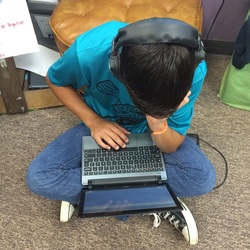 Silent Conversation using a Chromebook Silent Conversation using a Chromebook Even though technology is not mentioned in the blog post “A veteran teacher turned coach shadows 2 student for 2 days -- a sobering lesson learned” posted by Grant Wiggins, I have found that integrating technology into the classroom has the potential to actually deepen the “mistakes” noted by the anonymous classroom coach who spent two days shadowing a high school student. In the coach’s experience, “High school students are sitting passively and listening during approximately 90% of their classes” (Wiggins 2014). As a result of years of teaching with one-to-one laptops and Chromebooks at San Pasqual Academy, I have become very skilled at designing lessons to prevent my students from “sitting passively and listening.” My students are always doing something--such as revising a play, working on a group media project, or annotating an article. I am proud of my ability to harness online collaboration tools to support communication, but recently realized that simply helping my students actively engage and decreasing my talking time was not enough. Last year my school’s new instructional coach, Tracey Makings (@MakingsTracey), shared her insight after multiple observations of my classroom: my students were not talking. They were writing, reading, and creating, but they were not being given opportunities to practice and develop the skill of codeswitching into academic talk. And, our daily think-pair-share based on a news article only provided approximately two minutes of talk time for each student. Following my coach’s advice, I went into this year with a goal of helping my students engage in rigorous academic talk. In order to accomplish this classroom goal, I intentionally scheduled opportunities for face-to-face conversations, collaboration, and presentations. And, I had to put the Chromebooks away. I continued take advantage of my learning space; I pushed the students into groups for discussions sitting and standing around our tall triangular desks arranged into squares of four while allowing others to cluster up using chairs and stools from our classroom lounge. I broke my paperless rule and wrote conversation starters on poster papers and/or printed them. Just doing this was a challenge. I have been paperless for so long that it was my routine to create written instructions for every single little lesson, including instructions of how to submit evidence for credit. I felt the need to type questions, write discussion directions, and have at least one student record their group’s responses. I felt like I had to have proof of their learning. But, as they began talking, I noticed that they ignored my printed instructions and only used the prompts. I slowly began to let it go and trusted myself to just listen, observe, and naturally join into conversations as needed. I learned to place one of my additional adults in groups that needed a little direct guidance and allowed more independent groups to form and even stray from the planned topics. During my current unit, I was finally able to completely unplug and allow natural academic conversations to occur. My freshmen just finished reading and discussing the novel Orphan Train by Christina Baker Kline. Throughout the unit, I read aloud to them, they placed sticky notes on sections of the text relevant to our essential question, and we discussed their selections. This evolved into discussion days with specific learning targets, such as asking follow-up questions, with time for everyone to practice a new skill as we talked about the text. During our last few days of reading the book, the students began naturally interrupting me with small verbal responses such as gasps and excited blurts. I could hear the murmur and sense their subtle movements as I read words that evoked emotions and thinking. I would pause. We would quickly have a whole-group conversation about the text and then return to reading and searching for relevant text excerpts. All of this was unplugged-the Chromebooks were neatly stored in the cart for the entire period. I even just used a pencil checkmark on my roster to note which students participated. If I had allowed myself to instead revert to sending the students off to have conversations using a discussion board or even just having the them read online while adding highlights and comments, we would have lost the moments of discussions sparked by shared emotional responses. Unlike instructional coach in Wiggins’s blog post who wishes she “could go back and change [her] classes now,” I am currently changing my classes. As many teachers work to integrate technology into their lessons, I am working to find a balance between screen time and face time. Works Cited Wiggins, G. (Ed.). (2014, October 10). A veteran teacher turned coach shadows 2 students for 2 days - a sobering lesson learned. Retrieved June 20, 2015.
1 Comment
6/20/2015 05:16:59 pm
Natalie,
Reply
Leave a Reply. |
@npriesterA collection of my learning from SDSU EDL 680 Seminar in Personalized Learning Archives
August 2015
Categories |
 RSS Feed
RSS Feed